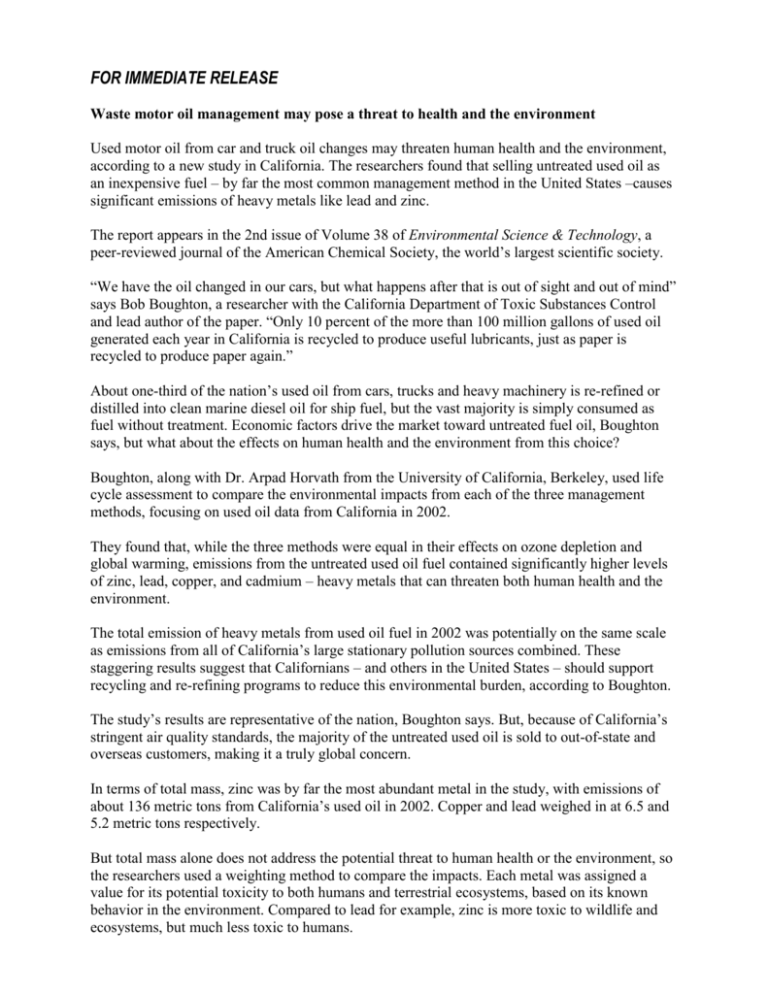Press Release - University of California, Berkeley
advertisement

FOR IMMEDIATE RELEASE Waste motor oil management may pose a threat to health and the environment Used motor oil from car and truck oil changes may threaten human health and the environment, according to a new study in California. The researchers found that selling untreated used oil as an inexpensive fuel – by far the most common management method in the United States –causes significant emissions of heavy metals like lead and zinc. The report appears in the 2nd issue of Volume 38 of Environmental Science & Technology, a peer-reviewed journal of the American Chemical Society, the world’s largest scientific society. “We have the oil changed in our cars, but what happens after that is out of sight and out of mind” says Bob Boughton, a researcher with the California Department of Toxic Substances Control and lead author of the paper. “Only 10 percent of the more than 100 million gallons of used oil generated each year in California is recycled to produce useful lubricants, just as paper is recycled to produce paper again.” About one-third of the nation’s used oil from cars, trucks and heavy machinery is re-refined or distilled into clean marine diesel oil for ship fuel, but the vast majority is simply consumed as fuel without treatment. Economic factors drive the market toward untreated fuel oil, Boughton says, but what about the effects on human health and the environment from this choice? Boughton, along with Dr. Arpad Horvath from the University of California, Berkeley, used life cycle assessment to compare the environmental impacts from each of the three management methods, focusing on used oil data from California in 2002. They found that, while the three methods were equal in their effects on ozone depletion and global warming, emissions from the untreated used oil fuel contained significantly higher levels of zinc, lead, copper, and cadmium – heavy metals that can threaten both human health and the environment. The total emission of heavy metals from used oil fuel in 2002 was potentially on the same scale as emissions from all of California’s large stationary pollution sources combined. These staggering results suggest that Californians – and others in the United States – should support recycling and re-refining programs to reduce this environmental burden, according to Boughton. The study’s results are representative of the nation, Boughton says. But, because of California’s stringent air quality standards, the majority of the untreated used oil is sold to out-of-state and overseas customers, making it a truly global concern. In terms of total mass, zinc was by far the most abundant metal in the study, with emissions of about 136 metric tons from California’s used oil in 2002. Copper and lead weighed in at 6.5 and 5.2 metric tons respectively. But total mass alone does not address the potential threat to human health or the environment, so the researchers used a weighting method to compare the impacts. Each metal was assigned a value for its potential toxicity to both humans and terrestrial ecosystems, based on its known behavior in the environment. Compared to lead for example, zinc is more toxic to wildlife and ecosystems, but much less toxic to humans. After adjusting for each metal’s relative toxicity and adding the results together, the researchers compared the effects of untreated used oil as fuel to both re-refining and distillation. In both comparisons, the toxicity potential of untreated oil was 150 times greater for terrestrial ecosystems, and more than five times greater for humans. Zinc and cadmium posed the greatest threat to ecosystems; lead and chromium drove the human health effects. The results provide further incentive for citizens and policymakers to encourage alternative used oil management strategies, possibly through incentives for treatment and by supporting markets for processed oil products, according to Boughton. But he is quick to point out what he considers the best option of all: use less oil in the first place. One way to accomplish this would be extending oil change intervals from the national average 4,500 miles to over 9,000 miles. “The bottom line is that motor oil quality has continually improved, but the oil filters have stayed basically the same for the last 30 years,” Boughton says. Most filters are made of a paper element that gets clogged after 5,000 miles, so the oil needs to be changed simply because it gets dirty. Yet high efficiency filters exist now and are available to the public. “If the auto manufacturers put these on new cars and called for these at each oil change, the used oil volume could be reduced by half from the transportation sector,” Boughton says. — Jason Gorss ### The online version of the research paper cited above was initially published Dec. 12 on the journal's Web site. Journalists can arrange access to this site by sending an e-mail to newsroom@acs.org or calling the contact person for this release. #13 Released Summary: The 1 billion gal of used oil generated in the U.S. each year are managed in three primary ways: rerefined into base oil for reuse, distilled into marine diesel oil fuel, and marketed as untreated fuel oil. Management of used oil has local, regional and global impacts. Because of the globally distributed nature of fuel markets, used oil as fuel has localized and regional impacts in many areas. In this paper, the human health and environmental tradeoffs of the management options are quantified and characterized. The goal of this study was to assess and compare the environmental impacts and benefits of each management method in a product end-of-life scenario using a life-cycle assessment (LCA) approach. A life-cycle inventory showed that 800 mg of zinc and 30 mg of lead air emissions may result from the combustion of 1 L of used oil as fuel (50-100 times that of crude-derived fuel oils). As an example, up to 136 Mg of zinc and 5 Mg of lead air emissions may be generated from combustion of over 50 M gal of Californiagenerated used oil each year. While occurring elsewhere, these levels are significant (of the same magnitude as reported total stationary source emissions in California). An impact assessment showed that heavy metals-related toxicity dominates the comparison of management methods. Zinc and lead emissions were the primary contributors to the terrestrial and human toxicity impact potentials that were calculated to be 150 and 5 times higher, respectively, for used oil combusted as fuel than for rerefining or distillation. Low profits and weak markets increasingly drive the used oil management method selection toward the untreated fuel oil market. Instead, both the rerefining and distillation methods and associated product markets should be strongly supported because they are environmentally preferable to the combustion of unprocessed used oil as fuel. “Environmental Assessment of Used Oil Management Methods” es034236p Researcher Contact Information: Bob Boughton California Environmental Protection Agency Department of Toxic Substances Control Office of Pollution Prevention and Technology Development 1001 I St., PO Box 806 Sacramento, CA 95812 Phone: 916.323.9586 Fax: 916.327.4494 E-mail: bboughto@dtsc.ca.gov Outside Experts: Denise McCourt, American Petroleum Institute, mccourt@api.org Doug Henderson, Western States Petroleum Association, www.wspa.org John Cutshall, Safety-Kleen, jcutshal@safety-kleen.com Darwin Hall, Evergreen, darwin@evergreenoil.com Steve Kerdoon, DeMenno/Kerdoon, skerdoon@demennokerdoon.com








